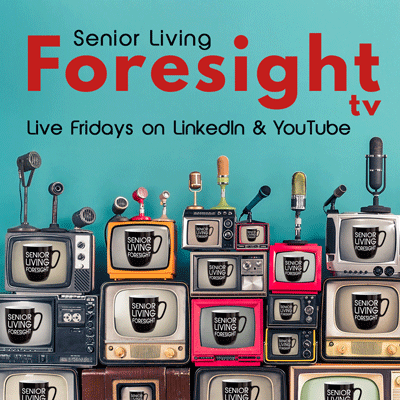By Russell Rush
I am sure you remember a time in the not-so-distant past when you were sitting at the table eating a bowl of cereal and milk before you went to school or work in the morning. Eating cereal has been routine for decades for most Americans since companies such as Kellogg’s introduced cereal products in the early 1900s.
Mysteriously, one day, many of us just stopped doing that. Yes, our behavior changed. I have not sat down in the morning and eaten a bowl of cereal in over 20 years.
Like with many other products and services, customers were informed about the benefits and, over time, accepted them. However, consumer sentiment and other market factors changed, and people stopped choosing this option.
This shift in sentiment is happening regarding senior living, but what is the industry doing to address it? How could this impact the baby boomer “surge” that most senior living companies and investors are counting on?
To fully explain what is happening in the senior living industry, we should look at history and see how senior living communities initially gained acceptance.
Yesterday to Today
In the early 1970s, innovators like William Colson, founder of Holiday Retirement, developed retirement communities to appeal to the masses. As consumers bought into the idea of a more leisurely lifestyle, care, and the benefits of community living, the small group of operators grew into a thriving industry. Over the years, various arrangements, such as independent living, assisted living, memory care, CCRCs, and others became available alternatives.
It is of interest to note that most people representing the Greatest Generation (born between 1901 and 1927), as well as the Silent Generation (born between 1928 and 1945), have never resided in a senior living community; instead, they have preferred to stay in their beloved homes for the rest of their lives.
In 2024, the last of the baby boomers turn 60, and the oldest will be 77 years old. As everyone knows, boomers represent the largest group of people who may use senior living services in the next 20-plus years.
Current estimates state that the United States has 76.4 million boomers. If we compare the available units to the number of older people who can afford senior living services, only a small percentage of potential customers move in. Why?
The Draw of Home
It is the natural tendency for most people to stay in their homes for the rest of their lives. This aspiration is as old as the Bible character Job. Some 4,000 years ago, he said, “I will die in my own home.” For thousands of years following Job’s statement, there were no senior living communities. Older people lived at home with their families and were cared for there. Compare this to the modern idea of aging in “place” — that place is their home with their family.
An option that aligns with the natural tendency to stay at home is the plethora of senior care franchises. As of 2022, there were over 400,000 home care businesses in the United States. These companies encourage family members to keep Mom and Dad at home with a caregiver rather than move them into a retirement community.
One such company, with 1,200 locations worldwide, is Home Instead. Instead of what? Instead of moving Mom and Dad into a senior living community. This concept is like sweet music to elderly seniors (and their children) who are biased toward the family home.
There is strong evidence that fewer consumers are willing to consider a senior living community as an option, not even giving it a cursory look.
The Missing Surge
If we are experiencing a surge in demand, as everyone is talking about, why is there a reduction in inquiries and tours pre- and post-pandemic? Shouldn’t we have a steady increase in prospects visiting our communities? In the last two years, why has the senior living industry still not returned to at least the same average occupancy it used to have? Despite a surge in qualified prospects, there is a palpable lack of interest in our service.
Occupancy rates of independent and assisted living communities before the COVID-19 pandemic provide evidence of consumer sentiment. The fact is that rates were declining in 2017, 2018, and 2019. The industry’s conclusion was that there had been overbuilding. But was that the case, when millions of financially and age-qualified seniors could have moved into a senior living community? No.
A reasonable person may conclude that there may not be the hoped-for surge of residents in the next few years. Many of the prospects on the horizon are still from the end of the Silent Generation, not necessarily boomers. Are boomers more conditioned than their parents to adopt senior living services? The answer is no.
Let’s stop momentarily and ask ourselves, would I live there when I get older or choose to stay in my own home?
The Path Forward
What is the industry doing to convince seniors and their families that living in a community is an excellent solution versus aging in place? So far, nothing. Marketing and sales efforts are the same as they have been for decades. The only difference is that we now have leading-edge customer relationship management systems to organize follow-up activities with prospects.
So, what is the solution?
The industry must recognize the consumer sentiment and adoption problem and realize that people require persuasion to use their services. Elderly seniors and their influencers are strongly biased toward staying home, and the senior living sales member needs to convince them to change their minds.
If we continue to do the old “show them around the community and chase them down” approach, occupancies may never get back to reasonable levels. There may be a surge, but this is not guaranteed, and since consumers are moving on from senior living in more significant numbers, we cannot be business as usual any longer.
We must change how we educate and interact with seniors and their families to improve occupancies. We must become educators on the value of community living and realize that even if someone is looking, they still need to be convinced to use our service.
The Kellogg’s Approach
So, what can we learn from breakfast cereal trends? Well, take a look at Kellogg’s adjustments. Even though in 1946 (when the first of the boomer generation was born), the U.S. population was 141 million, and today, the population is 336 million — quite an increase in potential cereal eaters — the company recognizes the shift in eating habits.
Breakfast for dinner, anyone? That is just one idea the company is promoting to adapt to the change in the consumer mindset.
It’s time to think outside of the “box.” Like Kellogg’s, we must take a different approach to the senior living consumer and their influencers. We must recognize that even if there is a demographic surge, it does not mean they are interested in buying senior living services. Instead, we must reason with them and persuade them that our communities are the best solution.
Russell M. Rush is the managing partner of R3R1 Consulting Group LLC, in Orlando, Florida. Recognized as a leading sales expert, Russell is also the author of R3R1: The Sales Formula for Success.








